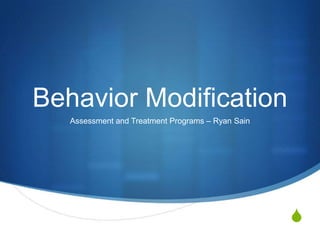
Cedp 402 assessment lectures
- 1. Behavior Modification Assessment and Treatment Programs – Ryan Sain
- 2. Assessment issues Behavioral assessment The focus is on data – not just suspicion This is one of the criteria that makes behavior analysis so effective – gather evidence and then treat based solely on that evidence
- 4. If not – then where should they be treated
- 6. Inform the client about the program, the policies, the procedures – make them informed
- 7. Is there a crisis? Abuse, suicide, etc
- 8. This means immediate treatment and possibly sending to other practitioners
- 9. Making a dsm4 diagnosis – sometimes required
- 11. Sources of data Indirect Interviews with client and people close to them Questionnaires Self report Life history Behavioral checklists, etc Role playing Useful when not able to observe in the specific situation Self monitoring
- 12. More sources Direct assessment Direct observation – most preferred method Functional analysis This is looking for the controlling variables – and demonstrates them with experimental control.
- 14. Topography
- 15. Develop checklists – how should the behavior ‘look’?
- 16. Frequency (rate)
- 17. Clear definition is the key – used for discrete behaviors
- 18. Record time and instances
- 19. Plot (frequency graph; cumulative graph)
- 20. Duration (relative duration – amount of time per a period)
- 21. Used for continuous behaviors
- 22. Intensity
- 24. Recording Methods Continuous recording Record all instances of the behavior over a given time period Interval recording Divide the time period into segments of short periods (a few seconds) Record occurrence and non- occurrence Partial Interval and whole interval recording Time sampling – every hour – observe for 10 seconds (randomize?)
- 25. Accuracy Interobserver agreement (reliability) Decreased by poor definitions, poor recording procedures, poor data sheets, poorly trained observers Calculating IOA Compare total scores (lowest divided by highest) Agreement/agreement + disagreement (quite accurate)
- 26. Functional Assessment In functional assessment we are looking for the causes of behavior (or the likely causes of it) We usually focus on problem behavior We will use all of the techniques presented in the last chapter But our primary focus will be on direct observation
- 27. Procedures Describe the behavior Define ecological events Define antecedent events (for occurrence and non-occurrence) Identify consequences What can the person do instead? What should you avoid? History Start observations – look at competing behaviors Provide summary statements
- 29. Who benefits? The client or others? Must be at least non harmful to the client.
- 30. Can the problem be operationalized? If you cant agree on the behaviors in question – do not continue.
- 31. Is the problem important to the client or others?
- 32. Will you need another specialist?
- 33. Can the problem behavior be easily managed?
- 34. Can you generalize beyond the program?
- 35. Can you get assistance from others? Can you control people who may hinder you?
- 37. Steps to building a good program There is as much of an art of building a good program as there is a science. But there are a bunch of general questions that you want to ask as you are building a program. The ones listed in your book should lead you to a quality program – and over time you will become better are knowing which questions to ask and it will become more natural.
- 38. Program Maintenance and Evaluation Did it work? How do you know? What do you do if it didn’t work? If it did work – plan for follow ups. Identify the costs Communicate the program to others if successful.
